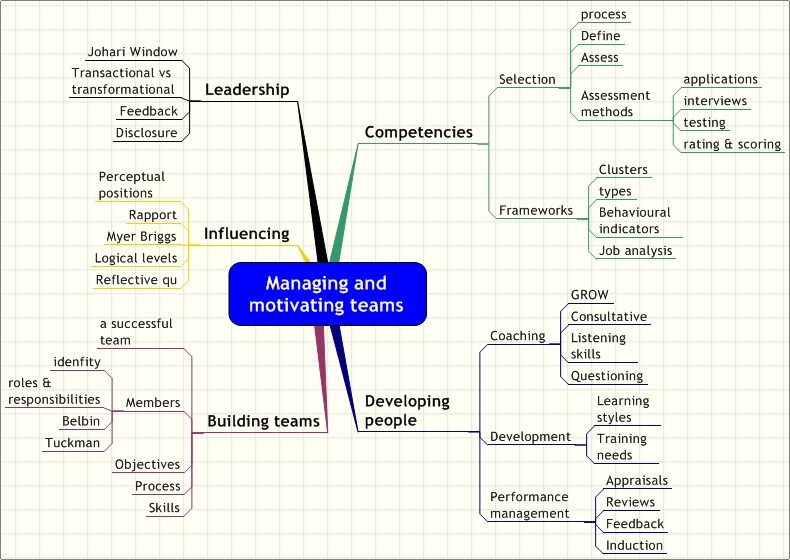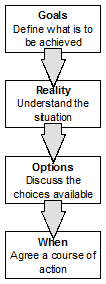Good practice in managing and motivating project teams includes using competencies and coaching techniques to build successful teams, facilitating personal and professional development, and influencing with strong leadership skills.stakeholdermap.comLearn how to improve the performance of your team by getting the right people, developing their skills, building rapport, and making the most of your Leadership skills.
The mind map below summarizes the best practice in managing teams:
Competencies
Getting the right people on your team
Competencies are designed to help get the right people for a team.[Competencies are] generally defined as the behaviours that employees must have, or must acquire, to input into a situation in order to achieve high levels of performance" (Lees, 2011).However, they can also include descriptions of tasks or outputs, and most companies adopt a blend of tasks and behaviours. In a survey, IRS identified the top six areas of use for competencies.
- Performance management/appraisal
- Personal development plans
- Management training and development
- job descriptions
- Person specifications
- Management selection. (IRS 2004/2005).
Competency frameworks can be used to select the right people for the team by identifying the job tasks, matching the competencies, finding the priorities and if necessary leaving some out if they can be developed quickly. This will give a competency list that can be used in adverts, job descriptions and as a basis for interview questions. Competencies can also contribute to the development of a performance management system..
Performance management
Armstrong and Baron define performance management asa process which contributes to the effective management of individuals and teams in order to achieve high levels of organizational performance. As such, it establishes shared understanding about what is to be achieved and an approach to leading and developing people which will ensure that it is achieved. (Armstrong and Baron, 2004)Performance management is an on-going process rather than a one off event. Development needs and objectives are identified usually at a yearly appraisal or at the employees induction, actions are taken that might include:
- job related training,
- mentoring,
- coaching,
- involvement in new work,
- reading and self-paced learning.
Performance should be reviewed in interim review(s), and then progress and further development needs can assessed in the next appraisal.
Project team members need an induction to their role
All employees should receive an induction (or introduction) to their role. This should cover office processes and procedures, health and safety, terms and conditions, culture and values as well their role and the objectives for their role.The induction will form the basis of a personal development plan that will include setting personal development targets, establishing performance objectives, facilitating career progression and monitoring progress.
The process of agreeing objectives and development needs is part of the performance management system and is usually written in terms of objectives or goals. These are often written using the acronym 'SMART': specific, measurable, achievable, relevant and time bound..
Developing the team
The development of personal development plans and the success of the performance management process is supported by effective identification of training and development needs. A manager's knowledge of the individuals learning style will support the design of each development activity. Analysis of needs can be undertaken using a problem – centred approach, which focuses on performance gaps and identifies what skills and knowledge would fill those gabs, or by matching an individual's competency profile with the competencies for the job.Coaching
The manager's role in performance management is consultative. Coaching by managers encourages their team's development and learning. Managers can make use of the GROW model to structure coaching sessions and EARS to facilitate empathetic listening.The GROW coaching model
Effective listening
Effective coaching needs to be supported by attentive listening and effective questioning. Effective questioning uses powerful questions to gather more information, clarify, identify viewpoints, and probe assumptions and reasoning. Questioning needs to be supported by effective listening in which Managers need to:- empathise with the speakers perspective,
- show attention through their body language
- acknowledge and respond to the speaker,
- show their understanding by reflecting on and summarizing what has been said.
Building teams
A successful project team is not necessarily easily defined as they are more transitory than operational teams. Project teams will vary in size over the project life cycle with contributions at various points from members who may be part-time, work remotely or involved in several different project teams. A lot of project teams are virtual teams (remote teams) drawn from a number of separate operational teams.Understand the stages of team development
More successful project teams are likely to have an understanding of Tuckman's model of team development through the stages of Forming, Storming, Norming and Performing and will understand the importance of different team roles and working/learning styles (for example Belbin's team roles).Four areas for effective team working
Bee and Bee (1997) identified four areas for effective team working; members, objectives, process and skills. All members of the team need to be identified and their contribution determined. Organizational, project, team and individual objectives need to be aligned.project team members need to have the key skills to work effectively together and clear processes need to be established to control the project.Set team goals
Setting personal and team goals help to foster team working, obtain 'buy in' and motivate the team to move forward. Developing a teamwork environment helps to promote a team identity and to move the team through the development stages.A teamwork environment is not just about the physical environment, it also includes agreeing roles and responsibilities, developing processes and procedures, providing regular team meetings and creating areas/arenas for sharing information or knowledge.
Influencing skills
Influencing is part of every day life and is crucial in enabling effective change. Effective project leaders use their influencing skills to change responses, feelings or behaviour. Often it is just about influencing people to see things in a different way. That does not necessarily mean seeing things as the project leader sees them. It may be about changing perceptions to solve a problem, resolve a conflict or foster team working.Techniques that can be used to improve influencing skills include:
- perceptual positions,
- logical levels,
- building rapport, and
- effective listening and
- questioning skills.
Build rapport
Building rapport is all about effective communication. For people to communicate effectively the right conditions have to exist.People who achieve rapport are able to match the style and communication needs of others. They pay conscious attention to matching the posture, expression, breathing, movement, voice and language patterns of the other person.
Pacing is another element of rapport building that is about acknowledging the state, style or feeling of others. For example; in a performance appraisal with someone who is nervous or hesitant a good influencer will pace the discussion to help them relax and open up.
By Matching and Pacing you can also start to lead conversations by asking probing, open questions. Sue Knight states that
Match, pace and lead mirrors the martial arts philosophy of going with the movement and using the energy of your partner to take them where you want to be.(Knight 1995)
Leadership
Research into leadership has identified two categories of leadership transformation and transactional:- Transformational leadership is about inspiring others to achieve greater things themselves.
- Transactional leadership is about command and control.
Most of the good practice in managing and motivating teams is interconnected. Competencies can help leaders to recruit the right team members, and provide a framework for coaching and mentoring. Great rapport building skills can increase disclosure and help in performance management.
Managing and motivating teams - references
Armstrong, A and Baron, A. (2004). Managing Performance: Performance Management in Action. McGraw-Hill Education / Europe, Middle East & Africa.Bee, R. and Bee, F. (1997). Project Management: The People Challenge. Chartered Institute of Personnel & Development.
Lees, J. (2011). The Interview Expert: How to get the job you want. Pearson Business.
Managing and Motivating Teams - Further reading
Brainstorming - a how to guide to the BEST way to BrainstormEffective Communication – Hints and Tips for Managers
Finding a New Job: get a free Mind Map guide to help you find your next job
22 Job interview questions on teamwork
How to Delegate - the Fast & Effective way
Here are our top ten tips for your next online team meeting!
How to smash any job interview question using STAR - a how to guide
Strategic Business Planning - Learn how to develop a Business Strategy and the process of Strategic Business Planning.



